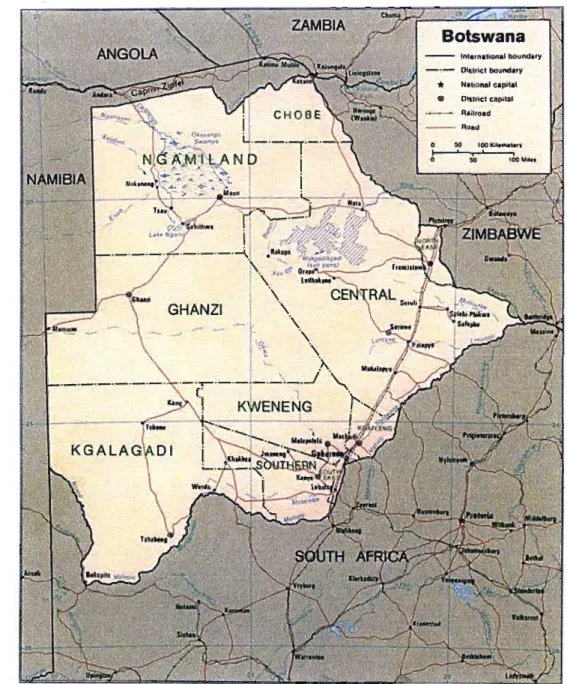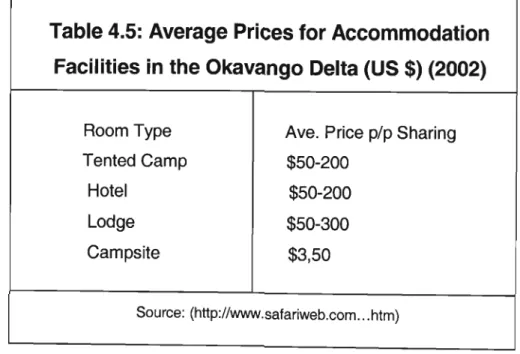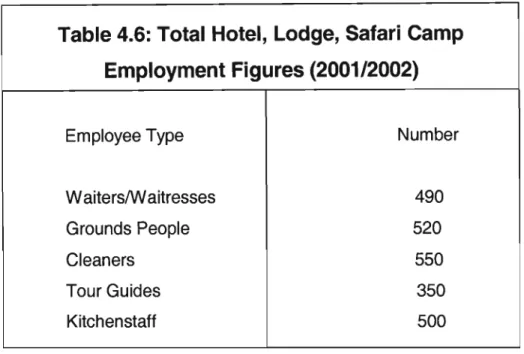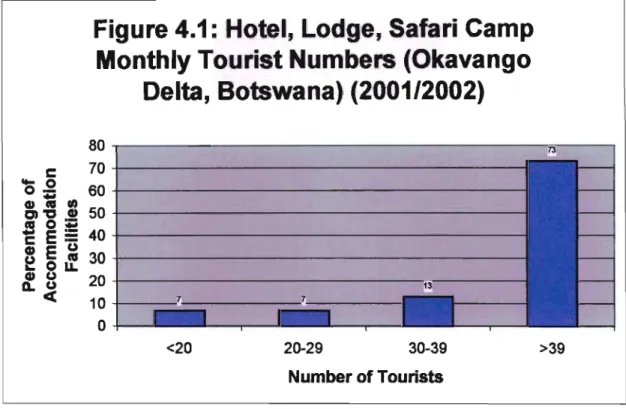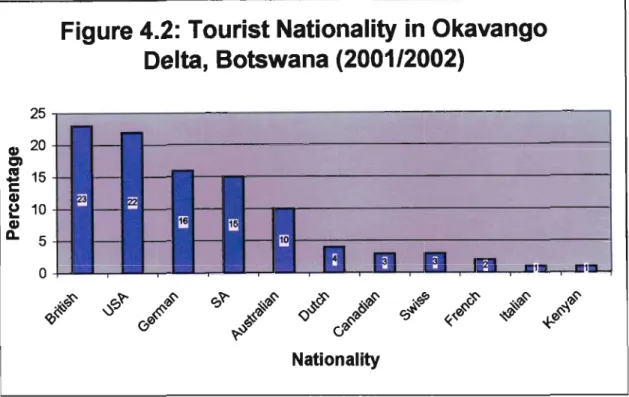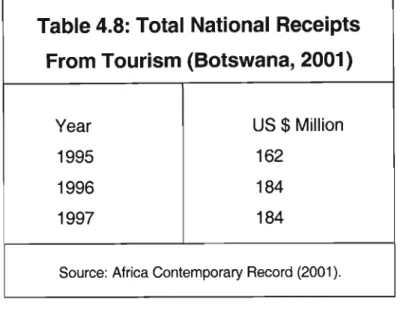The socio-economic impacts of migration in the Okavango Delta 149 The impact of tourism on local activities and strategies 151. Meals in the Okavango Delta region, Botswana Tourist concerns about local cuisine in the Okavango.
LIST OF ACRONYMS
DECLARATION
CHAPTER ONE
INTRODUCTION
- Study Context
- Geography and Tourism Research
- Rationale for the Study
- Research Methods
- Aim and Objectives
- Critical Questions to be Answered in this Study
- Tourism Indicators
- Study Area
- Data Sources
- Structure of Thesis
What factors prevent the development of local agricultural goods for the tourism industry in the Okavango Delta. What alternative options are there to develop a link between the tourism industry and local agriculture in the Okavango Delta.
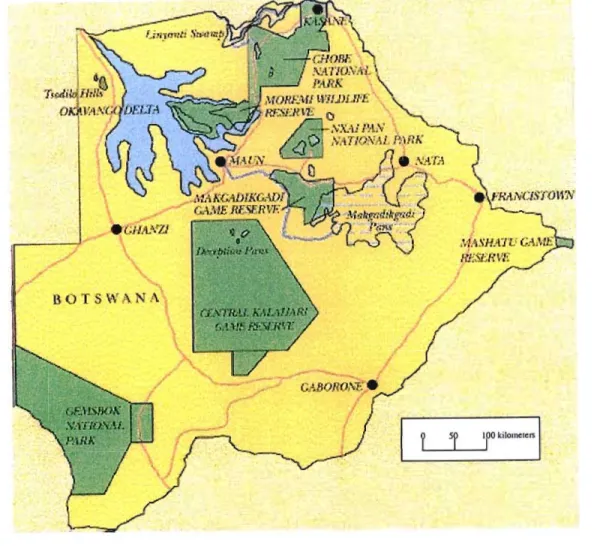
CHAPTER TWO
Tourism and Development: A Review
Introduction
Definitions of Tourism
Tourism plays an important role in the lives of many people and is undoubtedly one of the most influential economic and social phenomena. Some believe that tourism is a service industry that caters to visitors when they are away from home.
International Tourism
While conceptualizing tourism in its entirety is difficult, academic interest in the subject has not been halted by the lack of an accepted, official definition. These definitions of tourism are quite broad and therefore do not encompass the characteristics of international tourism and ecotourism in their entirety.
Eeo-tourism versus Mass Tourism
Others question whether the tourist traffic that ecotourism brings to sensitive wilderness areas harms the environment more than it helps preserve it (Smith, 1992). However, with or without local control, some researchers believe that ecotourism inherently has negative consequences (Schaller, 1996).
Tourism as an Industry
Tourism in Developing Countries
The Costs and Benefits of Tourism to Host Destinations
- The Economic Benefits of Tourism
- The Multiplier Effect
- Creation of Employment
- Negative Economic Impacts of Tourism
- Social Benefits of Tourism
- The Negative Social Impacts of Tourism
- Crime
- Environmental Benefits of Tourism
- Negative Environmental Impacts of Tourism
The extent of indirect employment available is determined by the degree of integration of the tourism industry with the rest of the local economy. Tourism development can also lead to changes in the arts and crafts of the host culture.
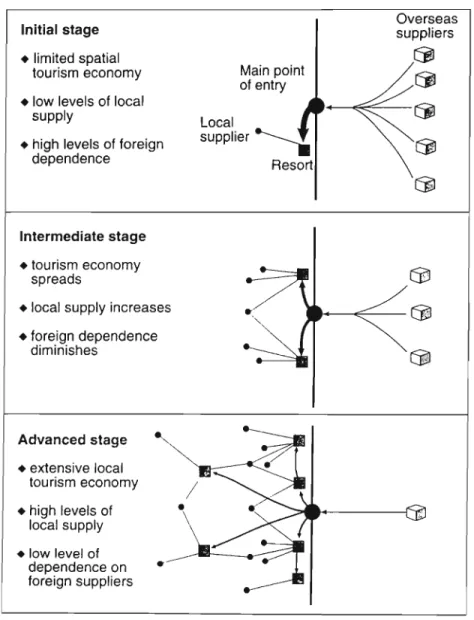
Tourism's Role in Development
Developing countries are generally characterized by a scarcity of capital and advanced technology, an inadequate infrastructure, a small and weak private sector and minimal experience in tourism development. The involvement of foreign capital and expertise in tourism development in Third World countries is also closely related to its economic level.
Foreign Aid
International tourism, as a strategy for development and growth, can be a positive force, but it is also widely criticized as it is often associated with a dependence on external sources of capital and expertise (de Kadt, 1979). Botswana, it is not possible to prevent the use of imported goods, as the agricultural and manufacturing industries cannot produce the range of products needed to sustain an international tourism industry (Veilas and Becherel, 1995).
Investment
The development of a Third World tourism industry depends, to varying degrees, on foreign investment. Tourism entrepreneurship will increase and the number of tourists will increase only if the investment is used to improve the attractiveness of the tourism product (Dwyer and Forsyth, 1994).
Globalisation and Tourism
The social, economic and environmental change that can occur in a host region is partly a result of globalization. With the development of international tourism, the likelihood of globalization increases, and with the growth of globalization, social, economic and environmental changes will occur.
Impact of Tourism on Agriculture Within a Global Setting
In the Seychelles, for example, the boom associated with the construction of tourist hotels, resorts, offices and the airport has placed unprecedented demands on the local labor supply and pulled many people out of the agricultural sector. In the Caribbean there is a widespread problem regarding the lack of integration between tourism and agricultural development.
Sustainable Tourism Development
Sustainable development is only possible if the quality of the environment and life in the community can be maintained indefinitely. In each location, harmony must be sought between the different needs of visitors, the place and the host community. This definition means that the carrying capacity of tourism is related to the quality of the environment and the quality of the recreational experience.
Summary and Conclusion
CHAPTER THREE
Okavango Delta in Botswana: A Socio-Economic Perspective
Introduction
The issues of land use arising from these activities are among the major concerns facing indigenous peoples at the beginning of the twenty-first century (Young, 1995). The first section gives a broad overview of the country of Botswana as a whole, and provides information on demography, agriculture and tourism. The second section provides general information about the study area: the Okavango Delta, and gives a brief account of the inhabitants of this region.
Background Information on Botswana
The Ngamiland district, which includes the Okavango Delta and Panhandle, is an exception because the major rivers in this area are somewhat perennial (Ndubano, 2000).
- Demographic Characteristics
- Socio-Economic Profile of Botswana
- The Economy
- Employment Status
- Income
- Natural Resources
- Land Use
- Changes in Land Use at National Level
- Agriculture
- Mining
- Trade
- Tourism
- Manufacturing
- The Okavango Delta Region
- Climate
- Soil and Vegetation
- Wildlife
- Socio-Economic Profile of Ngamiland District
- Population
- Employment
- Income
- Traditional Inhabitants of the Okavango Delta
- Traditional Lifestyles of the People
- Role of Women in the Community
- Social and Political Organisation
- Example of Traditional Way of Life in a Village in the Okavango Delta: Zankuyu
- Loss of Traditional Lifestyles, Language and Cultural Traditions
- Profile of Contemporary Rural and Agricultural Households in the Okavango Delta Region
- Profile of Contemporary Urban Households in the Okavango Delta Region
- Agriculture in the Okavango Delta Region
- Arable Crops
- Agricultural Production Constraints
- Horticultural Crops
- Livestock Production
- Disease and Mortality
- Marketing Outlets
- Tourism in the Okavango Delta Region
- The HIV/AIDS Pandemic
- Conclusion
Sorghum is usually grown on the eastern edge of the delta and corn on the west. Most of the animals in the Okavango Delta region are kept under the communal grazing system. The next chapter presents a detailed analysis of the impact of tourism on agriculture in the Okavango Delta region.

CHAPTER FOUR
Tourism Impacts on Agriculture in the Okavango Delta
Introduction
Finally, this chapter assesses changes in agricultural production in the Delta.
Tourism in the Okavango Delta Region
- The Growth of the Hunting Industry in Botswana
- The Beginnings of Conservation in Botswana
- Wildlife Administration
- The Growth of Modern Tourism in Botswana
However, it was not until the 1890s, when chiefs gained support from the Protectorate, that a quota and permit system for hunting elephants, giraffes and eland could be implemented (DWNP, 1997). The development of the Department of Wildlife and National Parks in the late 1960s led to the creation of the National Parks Act of 1968. This policy emphasized the promotion of high-cost, low-volume tourism and aimed to ensure that Batswana benefited from the development of the tourism industry.
Tourism in Botswana
There is now a movement to involve local communities in developing attractions based on traditions and culture, as opposed to just wildlife, as was the trend before. http://wildnetafrica.co.za. Botswana secured £8.3 million from the European Union in 1997 to develop a tourism program and extend a financial support program to investors in the tourism sector. However, this was due to the very low response rate to the 2000 hotel survey.
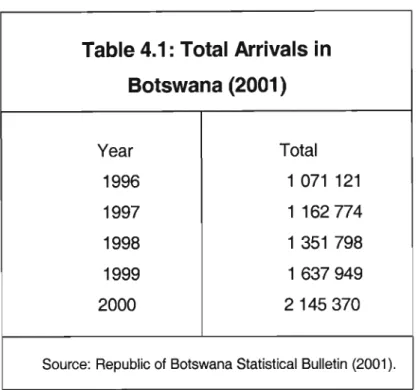
Tourism in the Okavango Delta
- The Tourism Accommodation Sector
- Tourist Facilities in the Okavango Delta
- Tourist Profile in the Okavango Delta
- The Demand and Supply of Fresh Produce in the Okavango Delta Region
The dominance of the tourism industry in the Okavango Delta by foreign interest has increasingly led to the loss of resource control by the local population (Ndubano, 2000). Lodges and safari camps in the Okavango Delta tend to differ in terms of standards and facilities on offer. Tourist accommodation facilities in the Okavango Delta tend to be independently owned, with no significant franchises operating in the area.
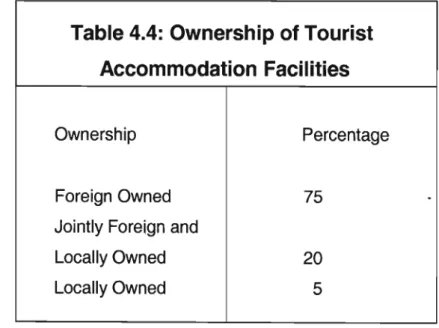
Consumed Accommodation Facility Meals in the Okavango Delta Region, Botswana (2001/2002)
Consequently, tourist facilities are obliged to provide the foods and dishes desired by the tourists (Table 4.12).
Botswana (2001/2002)
Food supply and demand patterns for the tourism sector have therefore developed independently of the local agricultural sector, increasingly relying on imported goods. In terms of the supply of fresh produce and processed foods to tourism facilities in the Okavango Delta, managers of all hotels, lodges and safari camps stated that they source their produce and processed goods from major supermarkets, butchers and wholesalers in the region. Maun, Francistown or Gaborone (Table 4.13). The companies in Maun and Francistown stated that all fresh produce except beef, chicken, eggs and.
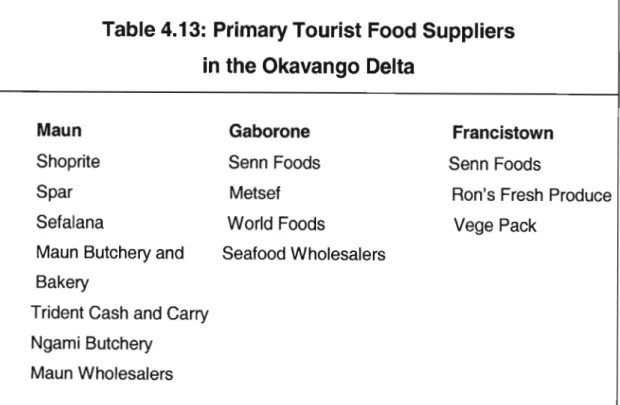
Botswana) (2001/2002)
Companies (2001/2002)
Facilities in the Okavango Delta
Tables 4.14 and 4.15 show that most of the fresh agricultural produce used by tourist accommodation facilities in the Okavango Delta must be imported from South Africa. According to managers of hotels, lodges and safari camps in the Okavango Delta, most felt that the unavailability of locally produced food was one of the main reasons why most of the food consumed by tourists had to be imported (Table 4.17).
Having to be Imported from South Africa
However, the quantity, quality and reliability of the products had to be of the same standard or compete with the imported products. In terms of the retail companies' source of supply for fresh produce, most produce was imported from South Africa (Table 4.18). Almost all the managers of these retail businesses stated that the unavailability of locally produced food was the reason why the majority of the fresh produce had to be imported from South Africa (Table 4.19).
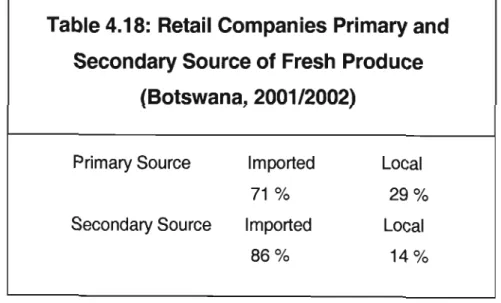
Foodstuffs Having to be Imported
Regarding Botswana's local beef, poultry and egg industries, 91 percent of retail businesses stated that inconsistent availability of these locally produced goods was a major problem. The main suppliers of the imported fresh produce and processed goods are several South African suppliers/producers. With regard to the purchase of food by the hotels, lodges and safari camps in the Okavango Delta, most managers felt that reliability of service was one of the main reasons for using the retail company as a supplier of fresh produce and goods (Table 4.21 ).
Okavango Delta, Botswana, 2001/2002)
According to operators of tourist accommodation facilities in the Okavango Delta, some of the problems encountered with locally grown fresh produce and goods purchased from retail businesses included the inconsistent availability of these locally produced goods. These would include beef, poultry and sea bream products and a limited selection of maize and sorghum and other locally produced agricultural products (Table 4.22).
Locally Produced Goods, Supplied by Retail Companies
The Impact of Tourism on the Inhabitants of the Okavango Delta
- Changes in Land Use in the Okavango Delta
- The Local Inhabitants of the Okavango Delta
- Tourism as a Job Creator
- Migration in the Okavango Delta
- The Socio-Economic Impacts of Migration in the Okavango Delta
- The Impacts of Tourism on Local Activities and Strategies
- Tourism Income
- Perceived Beneficiaries of Tourism
- Local Perceptions on the Major Tourism Beneficiaries
It is argued that the growth of tourism in the Okavango Delta has led to several socio-economic benefits. Agricultural production (livestock and crop production) is a core activity for almost all rural households in the Okavango Delta. The tourism sector in the Okavango Delta has led to the development of a large, informal, tourism-related craft and souvenir industry.
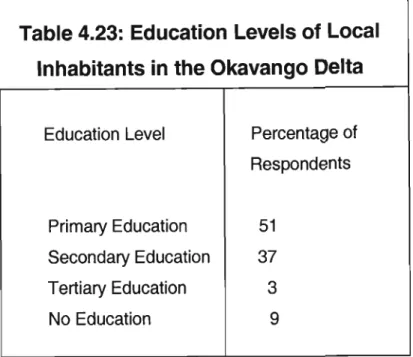
Changes in Agricultural Production in the Okavango Delta
- World Markets
- Agricultural Policies in the Okavango Delta
- Marketing Outlets in the Okavango Delta
- Rain Fed Agriculture
- Irrigated Agriculture
However, farmers in the Okavango Delta and elsewhere in Botswana tend to be reluctant to sell their livestock to the BMC for commercial gain. To achieve this commercial livestock production, supporting infrastructure must be implemented in the Okavango Delta. Irrigated horticulture in the Okavango Delta and elsewhere has been supported by the government through the Financial Assistance Policy (FAP).
Conclusion
Therefore, the government should target its assistance according to the potential of the different districts (Republic of Botswana Government White Paper No.1, 2002). The potential exists for Botswana to find a lucrative niche for some fruits in European markets by taking advantage of the difference in seasons. The impact of the development of the tourism industry in the Okavango Delta has not been uniform and varies widely within and between communities.
CHAPTER FIVE
Evaluation, Recommendations and Conclusions
- Introduction
- Socio-Economic Conditions in the Okavango Delta Region
- The Socio-Economic Impacts of Tourism in the Okavango Delta Region
- The Beneficiaries of Tourism in the Okavango Delta
- Tourism Employment in the Okavango Delta Region
- The Impact of Tourism on Agriculture in the Okavango Delta
- The Demand and Supply of Fresh Produce in the Okavango Delta
- Review of the Impact of Tourism on Agriculture in the Okavango Delta
- Recommendations
- Future Agricultural Developments in the Okavango Delta
- Government's Response to the Report
- Conclusion
In the Okavango Delta region, resentment by local communities of the international tourism industry is growing. Tourism accounts for 16 percent of the country's GDP, and is the dominant economic activity in the Okavango Delta region (Republic of Botswana Statistical Bulletin, 2001). The development of the tourism industry in the Okavango Delta region was initially seen as a possible means of achieving economic and social development and.
REFERNCES
Primary Sources
Government Reports and Documentary Material
Unpublished Reports and Papers
Journal Articles
